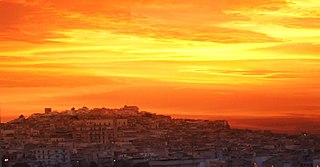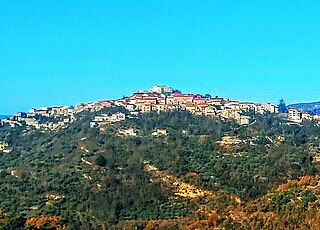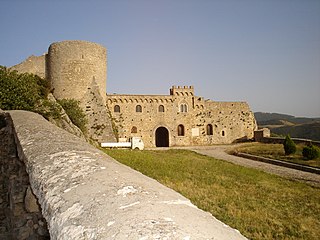
Canosa di Puglia, generally known simply as Canosa, is a town and comune in the province of Barletta-Andria-Trani, Apulia, southern Italy. It is located between Bari and Foggia, on the northwestern edge of the plateau of the Murgia which dominates the Ofanto valley and the extensive plains of Tavoliere delle Puglie, ranging from Mount Vulture at the Gargano, to the Adriatic coast. Canosa, the Roman Canusium, is considered the principal archaeological center of Apulia, and is one of the oldest continually inhabited cities in Italy. A number of vases and other archaeological finds are located in local museums and private collections. It is not far from the position on the Ofanto River where the Romans found refuge after the defeat of the Battle of Cannae and is the burial place of Bohemund I of Antioch.

The province of Foggia is a province in the Apulia region of Italy.

Savignano Irpino is a village and comune in the province of Avellino, in the Campania region of southern Italy.

Ariano Irpino, or simply Ariano, is a comune (municipality) in the province of Avellino, in the Italian region of Campania. With a territory of 186.74 square kilometres (72.10 sq mi) and a population of 22,535 (2017), it is one of the largest settlements in the Irpinia historical district and the modern province. Located 264 kilometres (164 mi) east-southeast of Rome and 104 kilometres (65 mi) east-northeast of Naples, the comune was granted the official status of città ("city") by a presidential decree of 1952, October 26; it has been recognized as an arts town, too.

Cerignola is a town and comune of Apulia, Italy, in the province of Foggia, 40 kilometres southeast from the town of Foggia. It has the third-largest land area of any comune in Italy, at 593.71 square kilometres (229.23 sq mi), after Rome and Ravenna and it has the largest land area of any comune in Italy among those that are not the provincial capital. In 2017, it had a population of 58,534.

Monteleone di Puglia is a hill town and comune of the province of Foggia in the Apulia region of south-eastern Italy.
Gioia del Colle is a town and comune of the Metropolitan City of Bari, Apulia, southern Italy. The town is located on the Murge plateau at 360 metres (1,180 ft) above sea level, between the Adriatic and Ionian seas.

Greci is an Arbëreshë town and comune in the province of Avellino, Campania, Italy, located about 100 km northeast of Naples and about 50 km southwest of Foggia. It is a mountain agricultural village lying astride the Apennines and represents the only existing linguistic minority in Campania; Arbereshe people have settled in Greci since the 15th century.

Montaguto is a town and comune in the province of Avellino, Campania, southern Italy.

Montecalvo Irpino is a town and comune in the province of Avellino, Campania, southern Italy.

Bugnara is a comune and village in the province of L'Aquila in the Abruzzo region of southern Italy. It is one of I Borghi più belli d'Italia.

Bovino is a comune and hill town at the eastern side of the Apennines in the province of Foggia, Apulia, southern Italy.

Anzano di Puglia is a small town and comune in the province of Foggia and region of Apulia in southeast Italy. It rises 760 metres (2,490 ft) above sea level.

Celle di San Vito is a town and comune in the province of Foggia of the Apulia region in southern Italy.

Torremaggiore is a town, comune (municipality) and former seat of a bishopric, in the province of Foggia in the Apulia, region of southeast Italy.

Panni is a village and comune in the province of Foggia in the Apulia region of southeast Italy.

Riesi is a comune (municipality) in the Province of Caltanissetta in the Italian region Sicily, located about 110 kilometres (68 mi) southeast of Palermo and about 20 kilometres (12 mi) south of Caltanissetta. As of 31 December 2004, it had a population of 11,678 and an area of 66.6 square kilometres (25.7 sq mi).

Aequum Tuticum was a Roman vicus in southern Italy, about 35 km east-northeast of Beneventum. The site lies beside Saint Eleuterio hamlet, overlooking Miscano Valley at an elevation of 575 m, about 15 km north of the modern Ariano Irpino, within Irpinia historical district. The vicus name is partly Latin and partly Oscan.
The Naples–Foggia railway is an Italian railway line connecting Naples, in Campania, with Foggia, in Apulia, crossing the Apennines at the saddle of Ariano through a series of tunnels.

The Arianese dialect, typical of the territorial area of Ariano Irpino, is a vernacular variety of the Irpinian dialect, belonging in turn to the Neapolitan group of southern Italian dialects. Like all Romance languages, it descends directly from Vulgar Latin, a language of Indo-European stock that has been widespread in the area since Roman times.





















